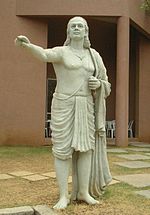Āryabhaṭa: Difference between revisions
(Content added) |
(Content Modified) |
||
| Line 13: | Line 13: | ||
of Indian mathematics and Indian astronomy. He flourished in the Gupta Era<ref>{{Cite web|title=Achievements of the Gupta Empire|url=https://www.studentsofhistory.com/the-gupta-empire}}</ref> and produced works such as the [[Āryabhaṭīya]] (which mentions that in 3600 Kali Yuga, 499 CE, he was 23 years old) and the Ārya-siddhānta<ref>{{Cite web|title=Āryabhaṭa|url=https://www.newworldencyclopedia.org/entry/Aryabhata}}</ref>. | of Indian mathematics and Indian astronomy. He flourished in the Gupta Era<ref>{{Cite web|title=Achievements of the Gupta Empire|url=https://www.studentsofhistory.com/the-gupta-empire}}</ref> and produced works such as the [[Āryabhaṭīya]] (which mentions that in 3600 Kali Yuga, 499 CE, he was 23 years old) and the Ārya-siddhānta<ref>{{Cite web|title=Āryabhaṭa|url=https://www.newworldencyclopedia.org/entry/Aryabhata}}</ref>. | ||
Āryabhaṭīya deals with both mathematics and astronomy. It contains 121 stanzas and the subject matter is divided into 4 chapters, called Pāda (section). | Āryabhaṭīya deals with both mathematics and astronomy. It contains 121 stanzas and the subject matter is divided into 4 chapters, called Pāda (section). | ||
| Line 39: | Line 37: | ||
# Circumference to diameter ratio π = 3.1416. | # Circumference to diameter ratio π = 3.1416. | ||
# The table of sine differences | # The table of sine differences | ||
#Solution of indeterminate equations | |||
#Theory of Earth's rotation | |||
#The astronomical parameters | |||
#Time and divisions of time | |||
#Theory of planetary motion | |||
#Celestial latitudes of the planets | |||
#Use of the radian measure in minutes | |||
The commentary on Āryabhaṭīya was written by Bhāskara I , Prabhākara, Someśvara, Sūryadeva , Parameśvara, Nīlakaṇṭha Somayāji, Mādhava. | |||
== See Also == | == See Also == | ||
Revision as of 18:59, 18 October 2022
Āryabhaṭa (476–550 CE) [1]was born in Pataliputra (Patna). He was an Indian mathematician and astronomer of the classical age
Āryabhaṭa | |
|---|---|
 | |
| जन्म | 476 CE Kusumapura (Pataliputra) |
| मर गया | 550 CE Pataliputra |
| युग | Gupta Era |
| उल्लेखनीय कार्य | Āryabhaṭīya, Arya-siddhanta |
of Indian mathematics and Indian astronomy. He flourished in the Gupta Era[2] and produced works such as the Āryabhaṭīya (which mentions that in 3600 Kali Yuga, 499 CE, he was 23 years old) and the Ārya-siddhānta[3].
Āryabhaṭīya deals with both mathematics and astronomy. It contains 121 stanzas and the subject matter is divided into 4 chapters, called Pāda (section).
Pāda -1 (Gītikā-pāda):Consists of 13 stanzas sets forth the basic definitions and important astronomical parameters and tables. It gives the definitions of
- Kalpa, Manu and Yuga which are the larger units of time
- Sign, degree and minute which are the circular units
- Linear units yojana, hasta, aṅgula
Pāda - 2 (Gaṇita-pāda) :Consists of 33 stanzas talks about Mathematics. The topics covered are Geometrical figures, their properties and mensuration ; problems on the shadow of the gnomon ; simple, simulatenous, quadratic and linear indeterminate equations. Methods to extract square root and cube root.
Pāda - 3 (Kālakriyā-pāda) :Consists of 25 stanzas dealing with various unit of time and the determination of true positions of the Sun, Moon and the planets. Methods to compute the true longitudes of the Sun, Moon and the planets.
Pāda - 4 (Gola-pāda) :Consists of 50 stanzas dealing with motion of Sun, Moon and the planets on the celestial sphere. Calculation and graphical representation of the eclipses and visibility of the planets.
Āryabhaṭīya is generally supposed to be a collection of two compositions : 1.Daśagītikā-sūtra: consists of pāda -1 stating the astronomical parameters in 10 stanzas in gītikā metre and 2.Āryāṣṭaśata : consist of second, third and fourth pādas having 108 stanzas in āryā metre).
Here are the notable features of Āryabhaṭīya :
- Alphabetical system of numeral notation defined by Āryabhaṭa is different from Kaṭapayādi system but much more effective in expressing number briefly in verse.
- Circumference to diameter ratio π = 3.1416.
- The table of sine differences
- Solution of indeterminate equations
- Theory of Earth's rotation
- The astronomical parameters
- Time and divisions of time
- Theory of planetary motion
- Celestial latitudes of the planets
- Use of the radian measure in minutes
The commentary on Āryabhaṭīya was written by Bhāskara I , Prabhākara, Someśvara, Sūryadeva , Parameśvara, Nīlakaṇṭha Somayāji, Mādhava.